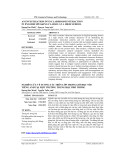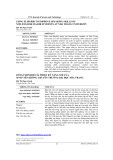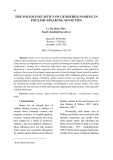
VĂN HÓA https://jst-haui.vn Tạp chí Khoa học và Công nghệ Trường Đại học Công nghiệp Hà Nội Tập 60 - Số 10 (10/2024)
30
NGÔN NG
Ữ
P
-
ISSN 1859
-
3585
E
-
ISSN 2615
-
961
9
STRATEGIES IN TEACHING ENGLISH SPEAKING SKILLS FOR THE FIRST-YEAR STUDENTS AT HANOI UNIVERSITY OF INDUSTRY
CÁC CHIẾN LƯỢC DẠY KỸ NĂNG NÓI TIẾNG ANH CHO SINH VIÊN NĂM NHẤT TẠI TRƯỜNG ĐẠI HỌC CÔNG NGHIỆP HÀ NỘI Nguyen Thi Chung1,*, Nguyen Thi Thanh Bang1, Pham Thi Bich Ngoc2, Dao Thi Van Anh3 DOI: http://doi.org/10.57001/huih5804.2024.321 ABSTRACT This study aims to explore the difficulties and propose effective strategies for teaching English speaking skills to the first-
year Students with Low English
Proficiency (SLEP). Two questionnaires were designed to investigate the learning and teaching of English-
speaking skills among 60 randomly selected students
with weak English proficiency from different classes at Hanoi University of Industry (HaUI), along with 6 teachers who participated in the teac
hing. The findings
reveal that a lack of confidence; difficulty organizing thoughts in English, limited vocabulary, challenges in u
nderstanding others' responses, pronunciation
issues, and fear of making mistakes are key factors contributing to poor learning outcomes among these students. Based on the
findings of the study, several
pedagogical recommendations are proposed for English
teachers. These include targeted vocabulary exercises, structured speaking frameworks, active listening
exercises, pronunciation drills, confidence-building activities, and fostering interactive learning environments to optimize students' learning outcomes. Keywords: Speaking skills, difficulties, strategies, low English proficiency, vocabulary TÓM TẮT Nghiên cứu này nhằm tìm hiểu những khó khăn và đề xuất các chiến lược hiệu quả để dạy kỹ năng nói tiếng Anh cho sinh viên năm nhất có trình độ tiế
ng
Anh yếu (SLEP). Hai bảng câu hỏi đã được thiết kế để khảo sát quá trình học tập và giảng dạy kỹ năng nói tiếng Anh của 60 sinh viên có trình độ tiếng Anh yế
u,
được chọn ngẫu nhiên từ các lớp khác nhau tại Trường Đại học Công nghiệp Hà Nội (HaUI), cùng với 6 giáo viên tham gia giảng dạy. Kết quả nghiên cứu cho thấ
y
rằng, thiếu tự tin, khó khăn trong việc tổ chức ý tưởng bằng tiếng Anh, vốn từ vựng hạn chế, khó khăn trong việc hiểu các câu trả lời, vấn đề phát âm và nỗi s
ợ
mắc lỗi là những yếu tố chính dẫn đến kết quả học tập yếu kém của những sinh viên này. Dựa trên kết quả nghiên cứu, một số khuyến nghị về
phương pháp
giảng dạy đã được đề xuất cho giáo viên tiếng Anh. Những khuyến nghị này bao gồm tăng cường các bài tập từ vựng chuyên biệt, bài nói có cấu trúc mẫ
u, các
bài tập nghe chủ động, luyện phát âm, hoạt động xây dựng sự tự tin, và tạo môi trường học tập tương tác để tối ưu hóa kết quả học tập của sinh viên. Từ khóa: Kỹ năng nói, khó khăn, giải pháp, trình độ Tiếng Anh yếu, từ vựng. 1Faculty of English Language, School of Languages and Tourism, Hanoi University of Industry, Vietnam 2Faculty of Applied Science, University of Transport Technology, Vietnam 3English Department, FPT-BTEC International College, Vietnam *Email: chungnt@haui.edu.vn Received: 08/9/2024 Revised: 24/10/2024 Accepted: 28/10/2024 1. INTRODUCTION In the context of global integration and development, improving English skills, especially speaking, has become a crucial need for Vietnamese students. However, many students with low English proficiency face significant challenges in learning and developing this skill.






























